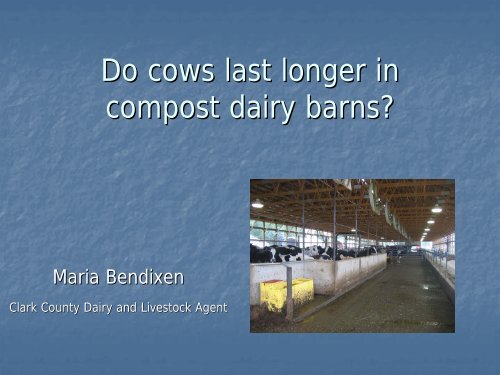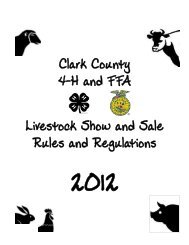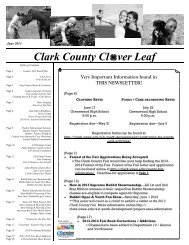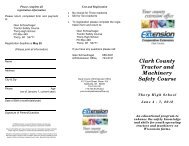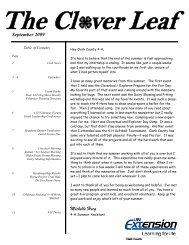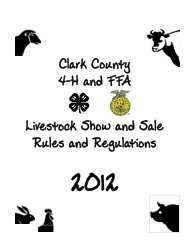Consistency: The Key to Farm Success and Life ... - Clark County
Consistency: The Key to Farm Success and Life ... - Clark County
Consistency: The Key to Farm Success and Life ... - Clark County
You also want an ePaper? Increase the reach of your titles
YUMPU automatically turns print PDFs into web optimized ePapers that Google loves.
Do cows last longer incompost dairy barns?Maria Bendixen<strong>Clark</strong> <strong>County</strong> Dairy <strong>and</strong> Lives<strong>to</strong>ck Agent
Compost Barn Banter• Our cows last longer• We have fewer problems with lameness• We are able <strong>to</strong> exp<strong>and</strong> internally• Our culling rates drop• We have more dairy heifers <strong>to</strong> sell
Compared <strong>to</strong> What?• Many of the farmers that are claiming thisbenefit <strong>to</strong> cows moved from tie stall barns<strong>to</strong> the compost barns.• What would happen if cows were movedfrom our other well known system of s<strong>and</strong>based free stalls?
Is True that…..• Culling rates drop?• More dairy heifers for sale?• Internal expansion?What do the numbers say?
Where do the numbers comefrom?• DHIA records from 7 farms who transitioned <strong>to</strong>compost barns• DHIA records from 7 farms who transitioned <strong>to</strong>s<strong>and</strong> bedded free stall barns.• Transitioning in the barn• Prior <strong>to</strong> being in the new barn (Pre)• First year in the new barn (Transition)• Beyond the first year (Post)• Age of the cows• First lactation heifers• Older cows (2+ lactations)
Things <strong>to</strong> note• Looking across all the farms• Tie-stall <strong>to</strong> new barn• Pipeline <strong>to</strong> parlor• Individual cow feeding <strong>to</strong> group feeding with TMR• Two farms with compost barns pasture in thesummer.• 5 free stall barns have bedded pack housing forfresh <strong>and</strong> transition cows.
Old System versus New DairyBarn• Up <strong>to</strong> 18 months prior <strong>to</strong> moving in<strong>to</strong> thenew barn (pre)• 1-1212 months in the new barn (transition)• 13-14 14 months in the new barn (post)
Does Herd CompositionChange?• Percent of lactating cows in first, second<strong>and</strong> third or more lactations.• If culling is reduced, expect the percent ofolder cows <strong>to</strong> increase <strong>and</strong> the percent of 1 stlactation heifers <strong>to</strong> decline
Herd Composition In Dairy Barns.100%90%80%70%60%50%40%30%20%10%0%Pre CB TransCBPostCBPreFreeTransFreePostFree1st 2nd or more
Culling• Did a cow or heifer that freshened leave theherd?• For each DHIA test date• Identify cows sold/died• Identify number of cows/heifers freshened• Culling number of animals leaving the herddivided by the number of animals freshening
Older Cows• Decrease in lameness• Average lameness prevalence in compostbarns was found <strong>to</strong> be 2-323 times less thanthe average in tie-stall or free-stall systems• Some farms were still exp<strong>and</strong>ing• Tend <strong>to</strong> keep a cow that might otherwisebe culled?
Value of reduced culling• Look at older cows• More Productive• Less calving difficulty• Lower Reproduction• Worth Less as replacements• For 100 Cow herd• Each culling percentage point will make one extracow.• If the farm will have 1 more saleable cow orheifer for a <strong>to</strong>tal value of $1850.
<strong>The</strong> Bedding Cost Question• Does improved culling offset the increasedcost of bedding?• Three systems:• Tie-Stall• Free-Stall• CDB• Difference in bedding cost• Tie-stall <strong>to</strong> CDB $19,812• Free Stall <strong>to</strong> CDB $16,999
Bedding CostsTie-StallFree-StallCompost$/cow/yr $20.88* $52.01* $219.00$/cow/day $0.06 $0.14 $0.60**$/year $2,088 $5,201 $21,900* www.finbin.umn.edu** Estimate
By the Numbers• Saw a 6 point drop in culling of cows fromtie stall <strong>to</strong> compost barn.• On a 100 cow farm = 6 cows year• $11,100 value• Saw a 2 point drop in culling of cows fromtie stall <strong>to</strong> freestall barn.• On a 100 cow farm = 2 cows per year• $3,700 value
For 100 Cow <strong>Farm</strong>Tie-StallFree-StallCompost$/cow/day $0.06 $0.14 $0.60**$/ Year $2,088 $5,201 $21,900Cull cow/yearValue Increase$0 $3700 $11,100
What about the transition year?• We often hear “I I will lose a lot of cowsthat won’t t adjust <strong>to</strong> the freestall barn.”• How many cows do these barns reallylose?• What did cull rate do in the transitionyear?
Transition Year Cull Rate ChangesCull rates over time50%40%30%20%10%Freestall BarnsCompost0%Pre Tranistion PostP
Transition• Buying cows <strong>to</strong> keep the barn full will costa lot of money.• If this requires more loan money debt percow will go up <strong>and</strong> interest payments willbecome a fac<strong>to</strong>r.• How long will that impact last?
Post Compost Barn• Both systems reduced the cull rate fromthe tie stall barn.• After the transition it comes down <strong>to</strong>managing costs of both systems.• Management in either system is key!!!
How solid are the numbers?• Data from 14 farms• More than a new barn effect• System change• Culling rate beyond the transition year• What is your starting point?
Other things <strong>to</strong> consider• Cost of manure s<strong>to</strong>rage???• Labor savings????• Nutrient value of the manure pack????• Use CDB in combination with othersystems????
Maria Bendixen743-5121maria.bendixen@ces.uwex.eduThanks To Margrot RudstromUniversity of MN


